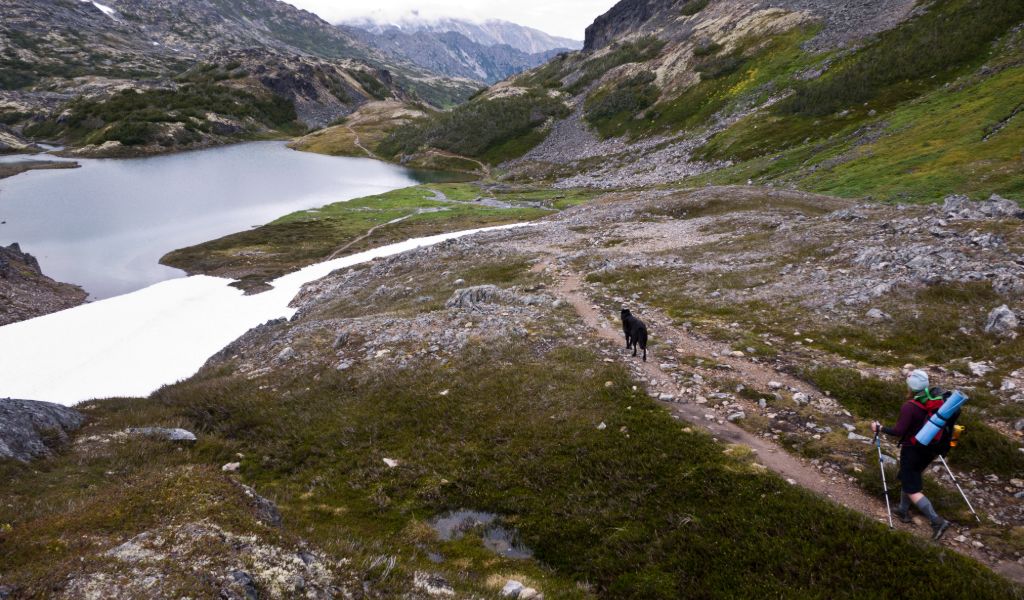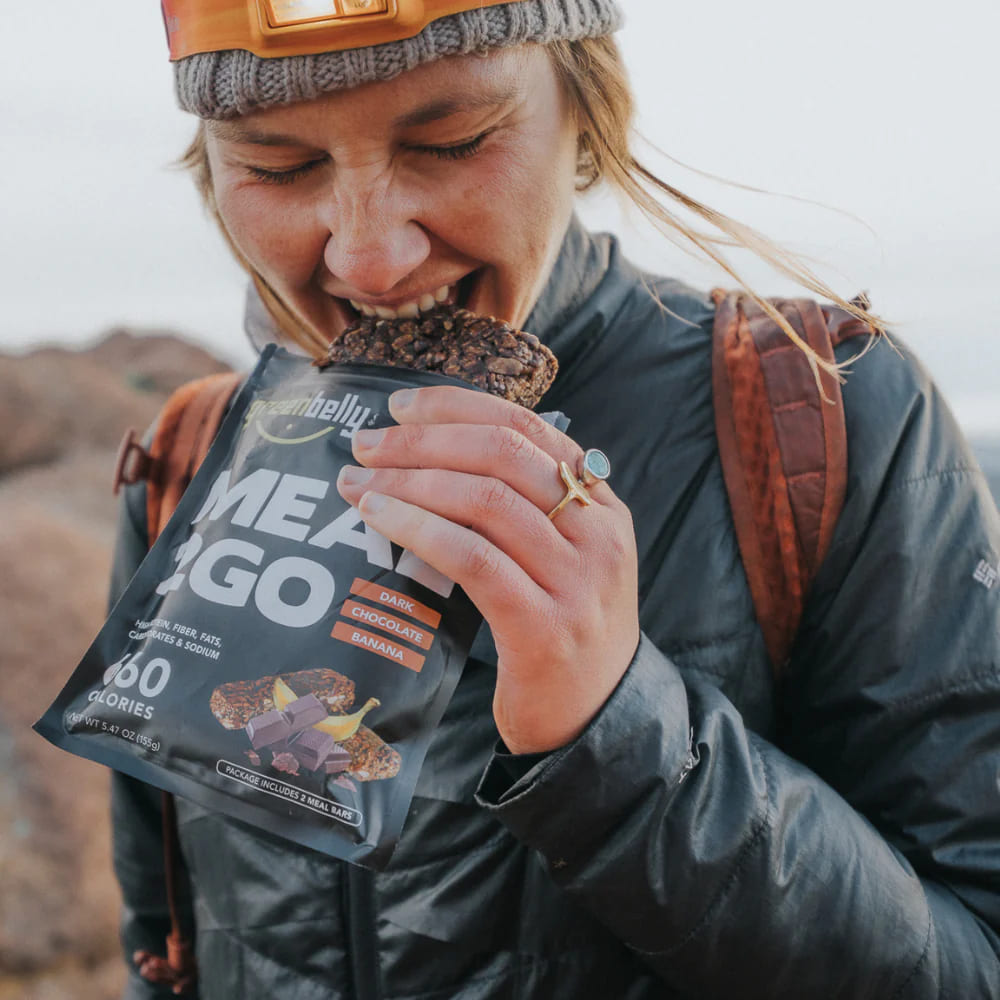Consuming enough calories while hiking is a never-ending challenge. This is especially true for thru-hikers who are walking day in and day out. We break down how many calories you could burn each day so you can adequately prepare your food for your next hike.
Calculating Your Backpacking Burn Rate
Calorie counting isn’t just for people who want to drop a few pounds (although it’s certainly useful for that purpose). To stay healthy and keep your energy up for the duration of your trip, it’s critical that you sustain your body with the right amount of fuel.
Having a general idea of your caloric expenditure helps you streamline the food you pack for optimal performance and health—whether your goal is to lose weight, build muscle, or simply to make it to the end of your hike without keeling over.
It can be a complex bit of calculation so we created this easy calculator to help you get an estimate of how many calories you burn in a mike of hiking.
Biggest Factors that Affect Your Burn Rate
BODY WEIGHT: THE HEAVIER THE PERSON, THE GREATER THE BURN
Your weight is an important factor in calculating your caloric burn rate. The general rule is, the more you weigh, the more calories you will burn per hour.
For example, a 180-pound male hiking three miles with a 15 lb pack will burn 312 calories while a 150-pound male will burn approximately 264 calories.
BACKPACK WEIGHT: THE HEAVIER THE PACK, THE GREATER THE BURN
It’s not only your weight that matters. But, the pounds on your back also need to be considered. The more weight you’re carrying, the more calories you’ll expand. Carrying a light load (like a day pack) burns approximately 50 more calories per hour on the trail. Supplies for a long backpacking trip add roughly 100 calories or more to your hourly burn rate.
For example, a 180-pound male hiking three miles on a flat surface with a 15-pound pack will burn 312 calories while the same person with a 30-pound pack will burn 330 calories.
GENDER: MEN TEND TO NEED MORE CALORIES
Men typically burn calories at a higher rate than women, due to their higher muscle-to-fat ratio. According to Livestrong, a moderately active man needs about 2,500 calories per day to maintain his weight, whereas a woman at the same activity level needs about 2,000.
 (Note we are not nutritionists. All data was gathered and estimated collectively from Self, Dietbites, Healthstatus, Nutristrategy and Outside Online)
(Note we are not nutritionists. All data was gathered and estimated collectively from Self, Dietbites, Healthstatus, Nutristrategy and Outside Online)
SLOPE: STEEPER TRAILS REQUIRE LOTS MORE ENERGY AND FUEL
Incline plays a huge role in how many calories you burn while hiking. Walking on an incline of 10 percent more than doubles the number of calories you will burn per hour. Hit an incline of 20 percent or greater and you will more than triple your caloric burn rate.
For example, a 180-pound male with a 15-pound pack hiking three miles an hour on a flat trail will burn 300 calories. The same person hiking at a moderate 10 percent grade will burn close to 700 calories.
PACE: THE FASTER YOU HIKE, THE MORE CALORIES YOUR BURN
Pace not only influences how quickly you’ll arrive at your destination, but it also affects how many calories it will take to get there. The faster you walk, the more calories you will burn. The average person will burn 300 calories per hour while walking at a moderate pace of three miles per hour. Bump that speed up to four miles an hour and you’ll burn an additional 100 calories.
TERRAIN: CHALLENGING GROUNDS INCREASE YOUR BURN RATE
Not many people realize that the terrain you are hiking influences how many calories you burn. Walking on a flat gravel road will burn much fewer calories than scrambling over downed trees and scaling rock slabs. Walking in sand, mud and snow also will increase the calories that you burn.
TEMPERATURE: NOT RELEVANT UNLESS YOU'RE SHIVERING
You may hear people claim that exercising in colder temperatures burns more calories, but that statement isn't 100 percent accurate. You will burn more calories in cold weather, but only if you are shivering to keep yourself warm. When you are hiking and generating heat, you will burn calories at an average rate. Only when you stop walking and start to shiver will you burn extra calories because of the cold weather. (Source)
 © Anthony DeLorenzo (CC BY 2.0)
© Anthony DeLorenzo (CC BY 2.0)
Why Do You Burn So Many Calories Hiking?
The calories you burn each day can be broken down into two main components: your basal metabolic rate (BMR) and the active calories you burn while exercising.
A) BASAL METABOLIC RATE
Your BMR represents the number of calories you need to keep your heart beating, your lungs breathing, and the rest of your body functioning. Your BMR is influenced by your gender, weight, height, age, and other factors. There are online calculators you can use to estimate your BMR which helps you figure out the bare minimum amount of calories you need to live.
Your BMR is only half of the equation when it comes to how many calories you burn each day.
B) ACTIVE CALORIES
You also burn calories throughout the day from being active. The more intense or the longer the duration of the activity, the more active calories you will burn. A typical hike can include short bursts of intense climbing mixed with long stretches of power walking. Consequently, these active calories account for the bulk of calories that hikers burn throughout the day.
Compared to most conventional forms of exercise, hiking burns calories at a slower, steadier rate. A run, for example, can burn nearly twice the amount of calories per minute as backpacking—but the average run usually only lasts between 15 minutes and an hour.
Even the easiest day out on the trail usually lasts many times the length and duration of a run. All that time on your feet adds up, and you may be surprised to learn the number of calories burned in a day of hiking.
 © Chance (Not A Chance)
© Chance (Not A Chance)
Calories Burned By Sport
HIKING: 300 TO 900 CALORIES PER HOUR
The number of calories you burn while hiking varies based upon the incline of your hike, the weight of your backpack, and the terrain. The average 180-pound male hiking on a flat surface with no backpack will burn a moderate 300 calories per hour. Hiking on steep and rugged terrain that requires you to use both your arms and legs while scrambling will burn close to 900 calories per hour. Over a full day of hiking, you can easily burn close to 5,000 calories.
WALKING: 200 TO 450 CALORIES PER HOUR
You can burn up to 450 calories per hour while walking. The total amount depends on your weight, the speed at which you walk, and the incline of the walk. The 200-450 calories per hour estimate above is for the average 180-pound male person walking on a flat surface. As soon as you add an incline, these values will skyrocket. For example, a 180-pound man walking at a rate of 3.5 miles per hour will burn 311 calories on a flat surface and a whopping 490 calories going uphill.
CLIMBING: 500 TO 900 CALORIES PER HOUR
Rock climbers make climbing look so graceful and easy, but it is the complete opposite. Rock climbing is an intensive activity that uses your arms, legs, core muscles, and more to proper yourself up and down a rock face. It burns a significant number of calories, up to 900 calories per hour for a 180-pound male on an aggressive climb.
CYCLING: 450 TO 700 CALORIES PER HOUR
Cycling burns at least 450 calories per hour, but this amount can change based on your weight, the type of bike you are riding, and the terrain through which you are riding. Riding a low-resistance road bike on a flat road will burn fewer calories than pedaling a mountain bike up a hill.
SWIMMING: 400 TO 900 CALORIES PER HOUR
Swimming is an excellent exercise for burning calories. It uses your arm and leg muscles allowing you to get an aerobic workout without the bone-jarring effects of walking downhill. Similar to hiking, the faster you swim, the more calories you will burn. A 180-pound person swimming freestyle for one hour at a fast pace will burn 817 calories, while a slow swimmer will only burn 572 calories.
 © Lani
© Lani
Expert Advice on Replenishing the Lost Calories
We asked two nutritionists what their recommendations were for fueling back up on the trail. Here are some of the insight they shared.
FOOD PLANNING: HOW MUCH FOOD IS ENOUGH FOOD?
Consuming enough calories is a major challenge for thru-hikers, especially for those who hike quickly or carry a heavy pack.
Hiking nutrition will vary based on the type of hike you are planning. As a general rule of thumb, the longer the hike, the more planning is required.
You can get by with regular food on a weekend trip where you are burning 3,000 calories per day. But on a thru-hike, you can burn up to 5,000 calories per day.
Hiking for weeks at a time with a calorie deficit will take its toll on your overall health and well-being, and will jeopardize your chances of finishing the hike.
You must pack enough fuel to offset the calories you are burning, especially on a long-distance hike. (here's a sample 5-day meal plan)
RISKS: WHAT IF I DON'T CONSUME ENOUGH CALORIES?
If you don’t consume enough calories each day, you will struggle on your hike. Your energy level will drop and you will have to rely on your mental strength to drag yourself over the next mountain top.
Your body also will begin to burn off extra fat and then turn to muscle to get the calories that you need. Needless to say, keeping your muscular strength is critical to finishing a thru-hike.
Except for paleo hikers who are conditioned to use fats for fuel, most people “need a constant carb supply to keep the glucose flowing to cells as you exercise,” says Diane Spicer, founder of Hiking for Her.
FOOD CHOICE: WHAT FOODS TO PACK?
"Fruit and nut energy bars, as well as trail mix, provide concentrated calories, along with a nourishing mix of macro-nutrients. A simple nut butter sandwich also does the trick, and is easy to make.", says EA Stewart of Spicy RD Nutrition.
"Carbohydrates and fat should supply the bulk of thru-hikers calories. In terms of ratios, aim for 55% carbohydrates, 35% fat, and 15% protein."
To consume enough calories, you need to skip the low-calorie food you eat at home and focus on calorie-dense backpacking food.
TIMING: HOW OFTEN SHOULD I EAT ON THE TRAIL?
Even if you pack enough calories, how you consume those calories throughout the day is important.
Spencer advises becoming a trail grazer during the day by snacking on “small amounts of dried fruit, cookies, or a small trail bar every hour to replenish carbs. Slow and steady fuel delivered to your cells will translate into stamina on the trail, without digestive upset.”
"It's important to get enough calories at the end of the day, something some hikers may skimp on if they're too tired to eat much."
At night, it’s important “to put your body into rest/digest mode, emphasize protein and fats, rather than the high proportion of carbs you needed on the trail," says Hiking for Her Spencer. Healthy fats have the added benefit of "making you feel satisfied and keeping your body warm throughout the night".
See related 41 Backpacking Food Ideas from the Appalachian Trail






 650-Calorie Fuel
650-Calorie Fuel